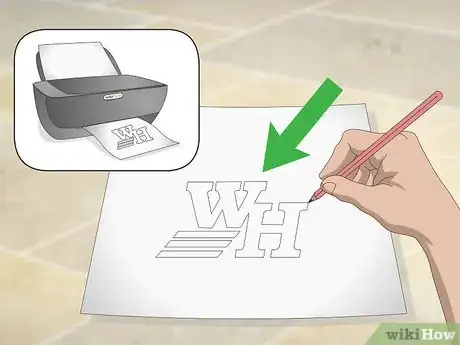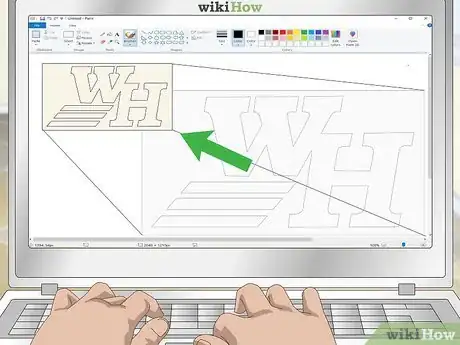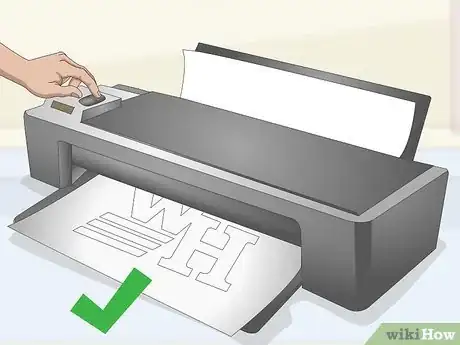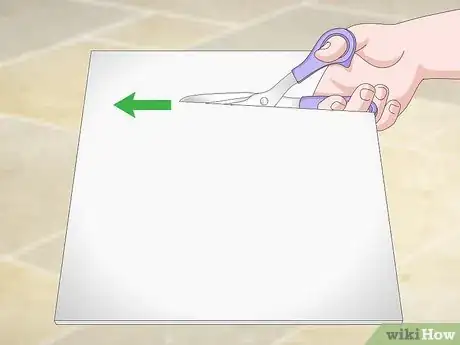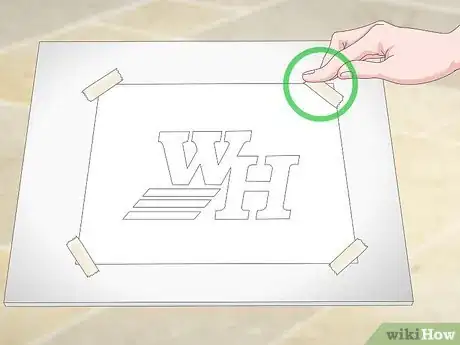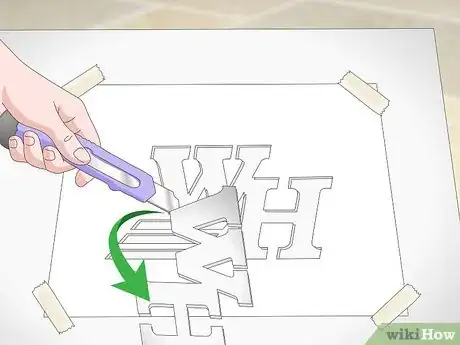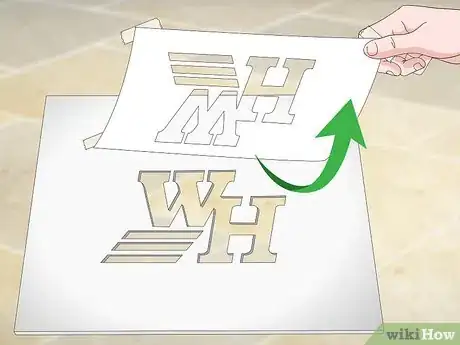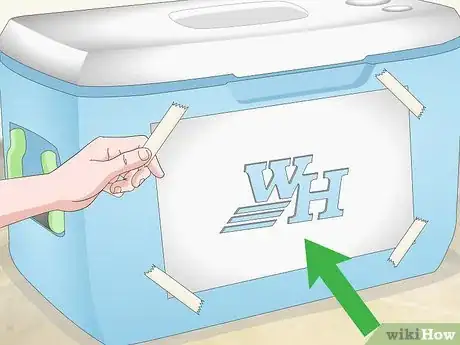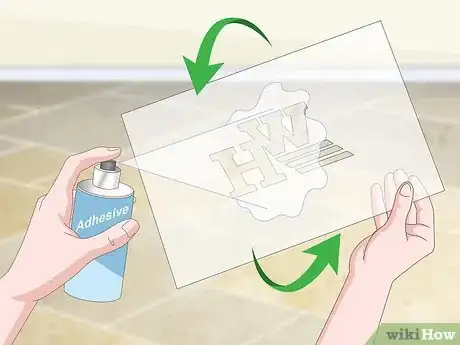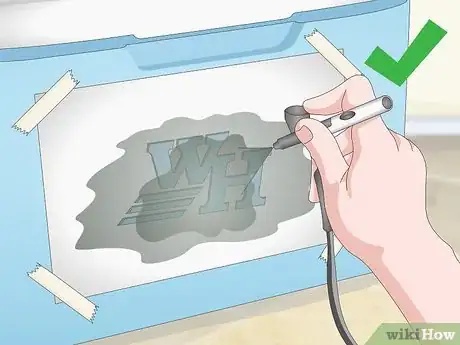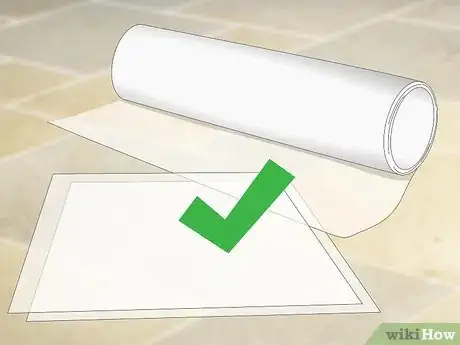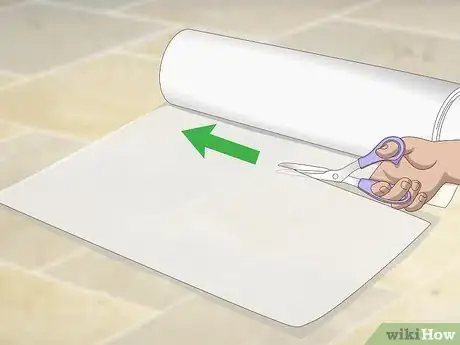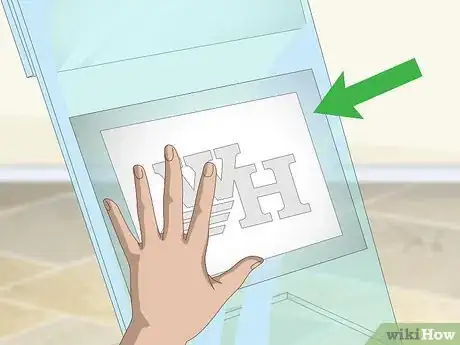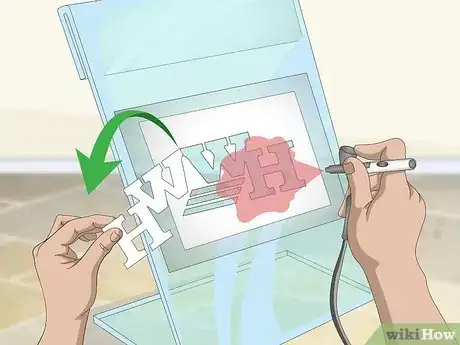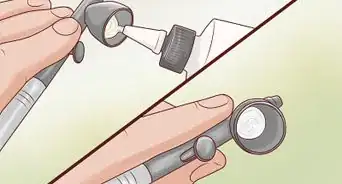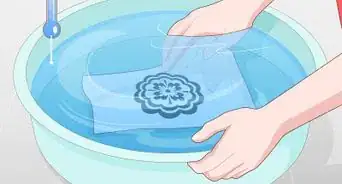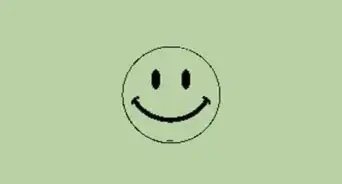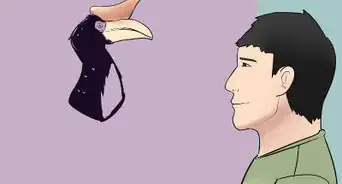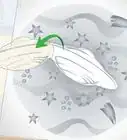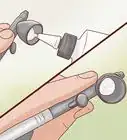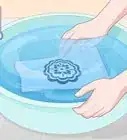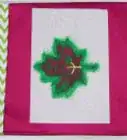This article was co-authored by Laura M. Johnson and by wikiHow staff writer, Jessica Gibson. Laura M. Johnson is a Professional Artist and the Owner of Laura Margo Murals & Custom Art in St. Paul, Minnesota. She has over five years of experience in the industry and has worked professionally across venture capital, communications, the arts, and beyond. She helps empower small and growing businesses to find their voices, share their stories, and grow their impact. Laura received her Master of Business Administration from the University of Minnesota - Carlson School of Management, and her Bachelors in Journalism and Communication Studies with a minor in Fine Arts from the University of Oregon.
This article has been viewed 156,393 times.
Airbrushing is a unique art form that allows artists to paint without using a brush. Many artists use stencils as a base for their designs. Once you've made an image you'd like to airbrush, you can create a simple stencil using paper, acetate, or a piece of thick flexible fabric. Or for more detailed stencils, apply frisket to your images and cut them out using a utility knife. Airbrush your item and lift away the stencil.
Steps
Creating a Stencil Design
-
1Determine the size of the image. Decide the location of the airbrush stenciled image and measure the space for the image. Create or scale the image to size.
- For example, on a t-shirt, decide if a large stenciled image covers the entire back of the shirt or a small stenciled image is on the front corner of the shirt.
-
2Draw or print the image. Draw the image or print the image on a piece of paper from the computer. With a computer, scan an existing image or download an image to print. Print the image in black and white.[1]
- If you're new to airbrushing, begin with a simple design. Draw or print an image that doesn't have too much detail to cut out.
- Glossy paper may be thick enough to use as a stencil. Just print and cut the image out and use it as your stencil.
Advertisement -
3Shrink the design, With a computer or photocopier, reduce the size of the image to fit the item being airbrushed. Crop or shrink the image until it's the size you want.
- Use computer editing software to adjust detailed images instead of photocopying them. Photocopiers can blur intricate details.
-
4Use a printing service to enlarge the image. If an image needs to be made bigger or an image is larger than your printer paper, use image-editing software to enlarge it or pay a printing service to print it.[2]
- Professional printing services are a good choice if you are printing an image in a large file format. Ask a local printing service about costs before you agree to print the image since prices may vary.
Using Paper, Acetate, or Thick Fabric
-
1Cut your stencil material to size. Get a heavy, smooth illustrator paper (such as Bristol), a sturdy piece of acetate, or non-fusible heavyweight interfacing (such as Pellon Peltex). Cut the material so that the sized image will fit on it. Leave 2"-3" (5-7.5 cm) beyond the image as a border. This prevents overspray from getting onto the item being airbrushed.[3]
- Acetate or interfacing is sturdier than paper or cardboard. If the stencil is to be reused, choose the longer-lasting material.
- With paper or cardboard, you can draw the image directly on the stencil material. The downside of using paper, cardboard, or even wood is that they are usually one time use stencils, because they will suck up the paint and can be a real mess to transport.
-
2Tape image to the stencil material. Lay the image on the chosen stencil material. With masking tape secure the image. There is no need to tape along the entire edge. Just ensure that the image won't slide around on the stencil material.[4]
-
3Use a utility knife to cut out images on stencil material. Place taped image on stencil material onto a cutting mat. With a utility knife carefully cut the image outline. Cut out any detail highlights wanted on the stencil.[5]
- The utility knife is useful for making stencil details. For example, to cut out circles, swirls, or defining lines within the image, use different blades to get the desired effect.
-
4Remove tape and image from the stencil. Peel away and discard tape from the edges of the taped-down image. Liftoff image to reveal the stencil. Pick up a paper, acetate, or thick fabric stencil and gently push on it to pop out the cut image. You now have positive and negative stencils.[6]
- The negative stencil is the material surrounding the image cut out while the positive stencil is the solid image cut out. You can easily use either of these popular types of stencils.
-
5Secure stencil to the object to be airbrushed. For a stencil with thick paper board or cardboard, simply tape the stencil to the surface to be airbrushed. Use basic masking tape. If the airbrushing fabric, smooth fabric completely and lay it flat on the ground. Do tape the stencil down so it doesn't move while airbrushing.[7]
-
6Spray back of the stencil with adhesive, if necessary. If using acetate, thin paper, or non-fusible heavyweight interfacing (Pellon Peltex), turn the stencil over and spray it lightly with stencil adhesive spray. Let adhesive rest for a few minutes.[8]
- Stencil adhesive spray is available at craft supply or hardware stores.
- If you don't let the adhesive rest, a residue will remain on the airbrushed item.
-
7Use your airbrush with your stencils. Place the stencil on the item to airbrush and tape down edges. Load airbrush and spray over the surface of the stencil. Slowly lift away the stencil and let the image dry.[9]
- Protect fabric from airbrush overspray by blocking off the rest of the fabric with taped-down plastic sheeting on the item.
- Remember to wear a respirator when using the airbrush.
Making Airbrush Stencils Using Frisket
-
1Purchase frisket film either in rolls or by the sheet. Frisket film is a transparent sheet with a slightly sticky backing that can be placed directly onto hard surfaces and removed without damaging existing paint jobs. Buy frisket at craft supply stores.[10]
- Avoid buying glossy frisket if using water-based paints as the paint will smear on the glossy surface.
-
2Clean the airbrush surface. Ensure that there is no dirt or grime on the material you want to airbrush.
- The frisket film stencil can be reused, but if the sticking surface is dirty, dirt will be picked up and the film will lose its ability to stick.
-
3Cut a piece of frisket film large enough to cover the entire design. To protect a large surface or a large image, simply lay down a large sheet of frisket or unroll enough frisket to cover the whole image. Use scissors to cut frisket from the roll.[11]
-
4Place unpeeled frisket over the image. Peel back a corner of the paper from frisket film and set the frisket sheet over the image. Slowly peel away the backing while smoothing the frisket down over the image.[12]
- If laying down a large roll of frisket, use a bench scraper or roller smoother to smooth and remove air bubbles from the frisket.
-
5Use a sharp utility knife to cut out the image. Set material with image on a cutting mat so material with frisket on top is on the mat. With a sharp utility knife apply a little pressure to cut the outline of the image through the frisket. If you press too hard, you will cut the material that is being airbrushed.[13]
- Lay frisket directly onto printed photo paper, heavyweight paper, or cardboard. Frisket is a great choice to make a detailed stencil. For simpler stencils, use paper, acetate, or cardboard instead.
-
6Remove frisket from image and airbrush item. Use the tip of the utility knife to gently pry up a corner of the frisket. Use fingertips to slowly pull away the frisket to reveal the image. Load airbrush with paint and airbrush over the stenciled image.[14]
- Remember to wear a respirator when using the airbrush.
- Keep the pieces of frisket film that were removed from the stencil. Put them back in place while airbrushing to keep overspray from affecting the design.
Community Q&A
-
QuestionI tried getting frisket at Michael's, no luck. Where are other places to look?
 Community AnswerIf Michael's doesn't have any, look on Amazon. They have a good variety. Graffix is a good brand.
Community AnswerIf Michael's doesn't have any, look on Amazon. They have a good variety. Graffix is a good brand.
Things You'll Need
Creating the Design
- Computer
- Photocopier
- Photo paper
- Paper
Making Airbrush Stencils Using Paper, Acetate, or Thick Fabric
- Scissors
- Masking tape
- Heavy, smooth illustrator paper (such as Bristol) or poster board
- Acetate
- Non-fusible heavyweight interfacing (such as Pellon Peltex)
- Cardboard
- Utility knife
- Stencil adhesive spray
- Paint mask
Making Airbrush Stencils Using Frisket
- Frisket sheets or rolls
- Bench scraper or roller smoother
- Scissors
- Utility knife
- Spray adhesive
- Masking or painter’s tape
- Paint mask
References
- ↑ https://www.youtube.com/watch?v=epqzH985kHI
- ↑ http://journal.alabamachanin.com/2013/09/diy-stenciling/
- ↑ https://www.youtube.com/watch?v=f6uDS73cLjk
- ↑ https://www.youtube.com/watch?v=f6uDS73cLjk
- ↑ https://www.youtube.com/watch?v=f6uDS73cLjk
- ↑ https://www.youtube.com/watch?v=f6uDS73cLjk
- ↑ https://www.youtube.com/watch?v=f6uDS73cLjk
- ↑ http://www.lauramaedesigns.com/2015/01/arts-crafts.html
- ↑ https://www.youtube.com/watch?v=f6uDS73cLjk
- ↑ http://www.jerrysartarama.com/free-art-instruction-videos/how-to-use-frisket-in-airbrushing-dan-nelson
- ↑ http://www.jerrysartarama.com/free-art-instruction-videos/how-to-use-frisket-in-airbrushing-dan-nelson
- ↑ http://www.jerrysartarama.com/free-art-instruction-videos/how-to-use-frisket-in-airbrushing-dan-nelson
- ↑ http://www.jerrysartarama.com/free-art-instruction-videos/how-to-use-frisket-in-airbrushing-dan-nelson
- ↑ http://www.jerrysartarama.com/free-art-instruction-videos/how-to-use-frisket-in-airbrushing-part-2-dan-nelson
About This Article
To make airbrush stencils, start by drawing or downloading the image you want to airbrush and shrinking or enlarging it to fit the item you’ll be painting on. Then, print the image and tape it onto a piece of illustrator paper or a sheet of acetate. Next, carefully cut through both layers along the printed lines with a utility knife. Once you’ve cut the shapes, remove the taped image so you’re left with just the stencil. Finally, use tape or spray adhesive to secure the stencil to the object you want to airbrush. To learn how to make an airbrush stencil using frisket film, keep reading!

